All You Need To Know About Cannabis Concentrates
The term “cannabis concentrates” is used everywhere in life, but if you're not sure what they actually are, you're not alone.
With so many types of cannabis concentrates available, it can be easy to get lost in the jargon.;
In this guide, we'll break down the different types of concentrates and explain how they work, so you can make an informed choice the next time you're shopping for cannabis products.
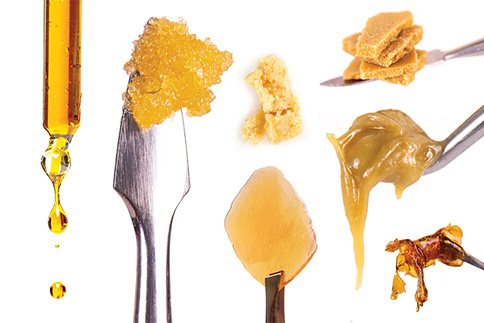
What arecannabis concentrates?
Cannabis concentrates have gained significant popularity in recent years, offering a more potent and efficient way to experience the effects of cannabis.
At their core, cannabis concentrates are products derived from the cannabis plant, created to capture and concentrate its active compounds—cannabinoids, terpenes, and flavonoids.
These compounds are extracted from the plant's trichomes—tiny, resin-producing glands that coat the surface of cannabis flowers.
The Potency of Cannabis Concentrates
One of the main reasons cannabis concentrates are so popular is their high potency.
While typical cannabis flowers contain THC levels ranging from 10% to 30%, concentrates can pack much more power.
Depending on the extraction method used, concentrates can contain THC levels anywhere from 40% to 80%—and in some cases, even higher.
This increase in potency has a significant impact on the user experience.
For instance, a small amount of concentrate can deliver a much more intense effect compared to smoking traditional flower.
This makes concentrates ideal for users who are seeking a stronger effect without having to consume large quantities of cannabis.
The high potency also means that concentrates are more efficient.
With fewer inhalations needed to reach the desired effect, concentrates can be a more cost-effective and time-efficient option, especially for seasoned cannabis consumers or those with a higher tolerance.
How are cannabis concentrates made?
Cannabis concentrates are made by extracting the active compounds from the plant material and concentrating them into a consistent, potent product.
There are two primary methods for making these concentrates:
1. Solvent Extraction:
In this method, solvents like butane, propane, or CO2 are used to strip cannabinoids and terpenes from the cannabis plant.
The process is followed by purging, which removes any residual solvent from the final extract
2. Solventless Extraction:
This approach uses mechanical pressure, heat, and filtration techniques to concentrate the plant’s active ingredients.
Although the process is more labor-intensive, it is popular among enthusiasts for producing natural, handcrafted products.
Different types of concentrates
Cannabis concentrates come in many forms, each with its own unique characteristics and methods of extraction.
The names of these concentrates are often inspired by their appearance, texture, or the way they are produced.
From the sticky, waxy consistency of "budder" to the glass-like shards of "shatter," each concentrate offers something distinct, both in terms of potency and flavor.
Let’s dive into the most popular types and see how they stack up.
Sift/Kief
More commonly known as kief, sift is a straightforward form of cannabis concentrate with intense results.
It's made by sifting the dried flower over mesh screens and collecting the trichomes at the bottom.
This resulting fine powder can easily be used in a vaporizer, added to joints, or sprinkled over bowls.
Some smoke shops will make "live sift." This is sift made from the same frozen plant matter as would be used with live resin.
This gives it a tastier, smoother hit than traditional kief.
Kief/sift is harder to come across these days as it has lower profit margins and potency than solvent extracts.
It's easy to collect your own at home by using a filtered weed grinder to collect and store your ground herb's kief.
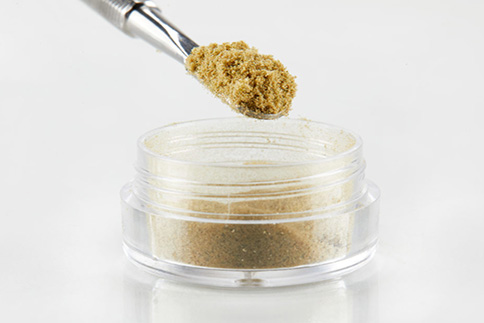
Hash
Hash has been around for millennia and can be made in several ways. Perhaps the easiest is to compress kief into a small bar.
Another way is with ice water, and to pass the extract through the screen to collect the concentrate.
Hash is often smoked by itself or mixed with the dry cannabis flower.
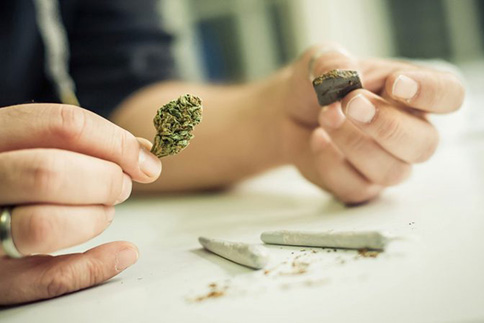
Charas
Charas is a form of hashish made slowly from hand rolling the flower and part of the cannabis plant's stems.
This releases a black tar-like substance that is worked into a ball. It plays a crucial role in the Hindu religion of India.
The god Shiva is renowned for his love of cannabis, and those devoted to his worship smoke charas as part of their religious practice.
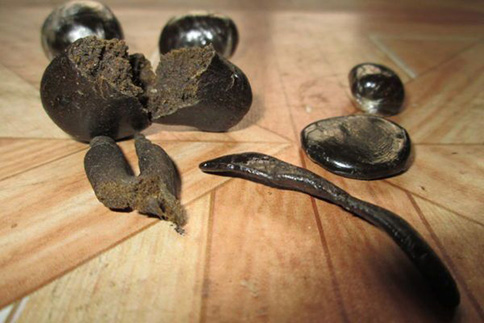
Bubble Hash
Sadly, bubble hash has begun to drop in popularity as stronger concentrates take over dispensary shelves.
While this is listed as a solvent-less concentrate, it is generated using water as a solvent.
However, water isn't considered a solvent, which can make its categorization a little confusing.
The easiest and hence most common way to make bubble hash is to put the marijuana in mesh bags.
A mixture of plant matter, water, and ice are filtered through them until a thick substance containing the resin is concentrated at the bottom.
This is then dried out, and the resulting product is bubble hash. It can be smoked like other hash, in a pipe, crumbled over a bowl, or mixed into joints.
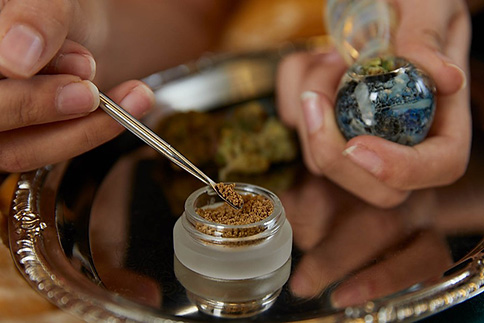
Rosin Hash
Rosin has seen a steep rise in popularity in the underground scene, mainly attributed to how easy it is to make.
All you need are some nugs of weed, parchment paper, and a hair straightener.
The hair straightener's heat and pressure push the resin out of the buds onto the parchment paper, and you're left with some rich THC oils for heady dabs on your dab rig.
It's also popular in weed stores, and the commercial makers use industrial heat presses to make it.
Its usually sticky and brittle, a little like shatter.
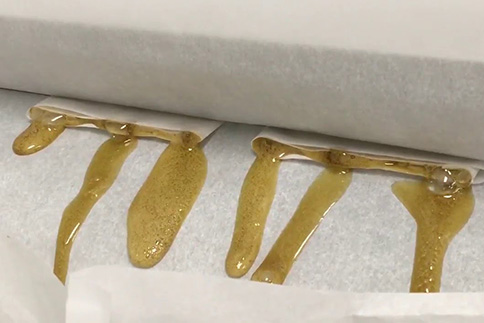
Wax
As its name suggests, this concentrate is waxy in nature. It can be very sticky and is often a creamy yellowish color.
It can be used in a vaporizer or a dab rig and varies in consistency from thick treacle to a more crumbly wax.
This consistency variation is due to the moisture and heat levels in the extraction process.
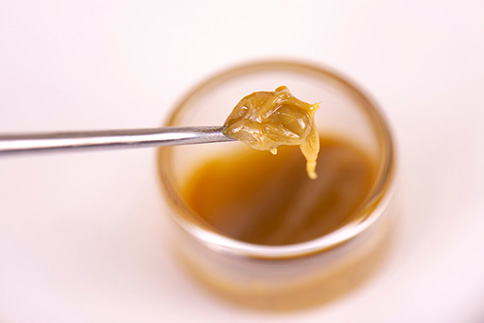
Shatter
Shatter is a common form of concentrate found in nearly all dispensaries.
It is sometimes sculpted into cool shapes and has a translucent glass-like consistency from which it derives its name.
It's one of the purest forms of marijuana concentrate and clear or amber in color. Its often made using butane as the extraction solvent.
It can give a hard-hitting high, and its composition makes it ideal for dabbing with rigs or using in vaporizers.
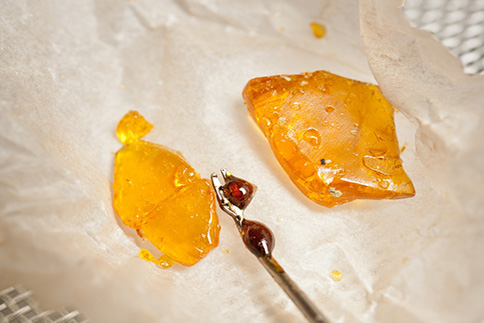
Pull and Snap
Pull and snap is very similar to shatter, but it has a taffy-like consistency.
As its name suggests, it is malleable and can be stretched; however, it will snap when a fast motion is used upon it.
Budder
Butter is a variety of wax concentrate that's become relatively popular.
It is typically extracted with CO2 or butane, so certainly not something you'd want to make at home.
Butter is made by blasting the solvent through marijuana, which extracts the THC.
This is then "purged" with heat and air pressure to remove the solvent.
It is a similar process used to create crumble wax and shatter.
A waxy paste substance can be created by agitating and whipping the extracted cannabinoids as they begin to crystallize.
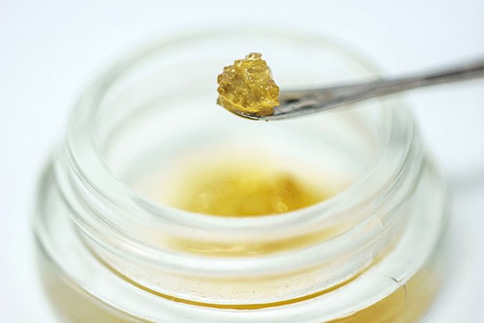
Crumble
Crumble wax is made in a similar way to shatter and budder.
A common way to make wax into crumble is by purging for a longer time at a lower temperature.
This preserves more terpenes and also makes for better-tasting concentrate.
Its crumbly form makes it a little harder to handle, although you can shave granules off and use them in vaporizers.
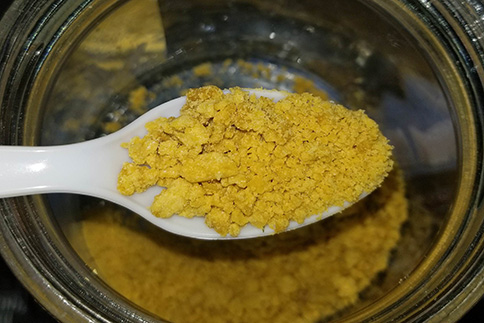
Live Resin
Live resin concentrates are made by flash freezing the fresh plant.
This skips the drying and curing phase, which results in a richer flavor as it preserves the terpenes.
Although you can make live resin with CO2 extraction, nearly all varieties that you'll find in dispensaries are made with butane extraction.
It's becoming ever more popular due to its strong flavor, which also attracts a higher price tag.
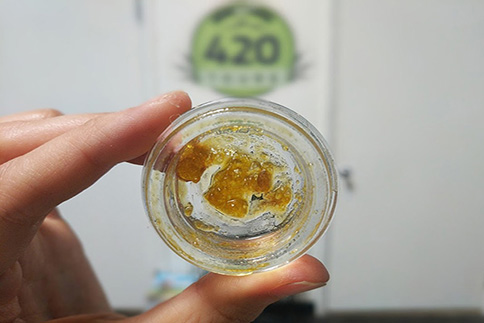
Distillate
Distillates are made through a process called molecular distillation.
Distilling hash requires taking winterized concentrates—butane or CO2 hash oil refined with alcohol or ethanol and then chilled at extreme temperatures—and then distilling them to concentrate the THC further.
The process is repeated to remove any impurities, such as leftover solvents or lipids, in the concentrate.
The result: a clear, odorless concentrate virtually free of solvents.
Distillation can take BHO or CO2 oil with a 70 to 85 percent THC potency and refine it to upwards of 95 percent.
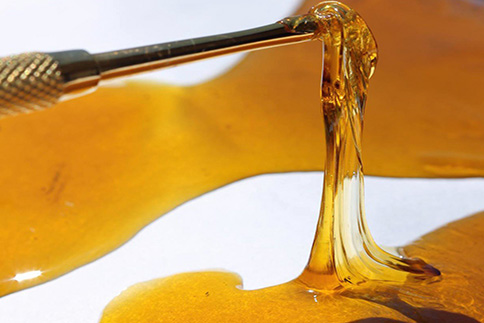
Terp Sauce
Terpenes are lost during the THC distillation process because the THC is separated from virtually every other compound, leaving an odorless, tasteless concentrate.
However, terpenes can be extracted from flowers and hash, too, and that's where terp sauce comes in.
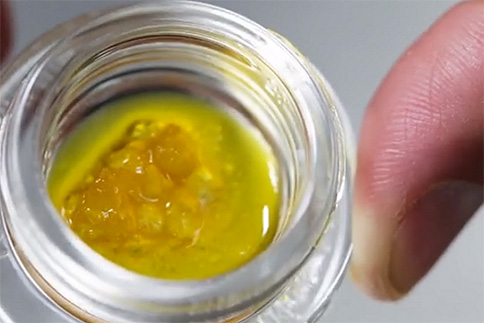
Conclusion
With so many cannabis concentrates on the market today, it’s easy to feel overwhelmed.
Understanding what you’re looking for is key.
Stay informed on the latest products and techniques to keep your cannabis experience fresh and exciting.
